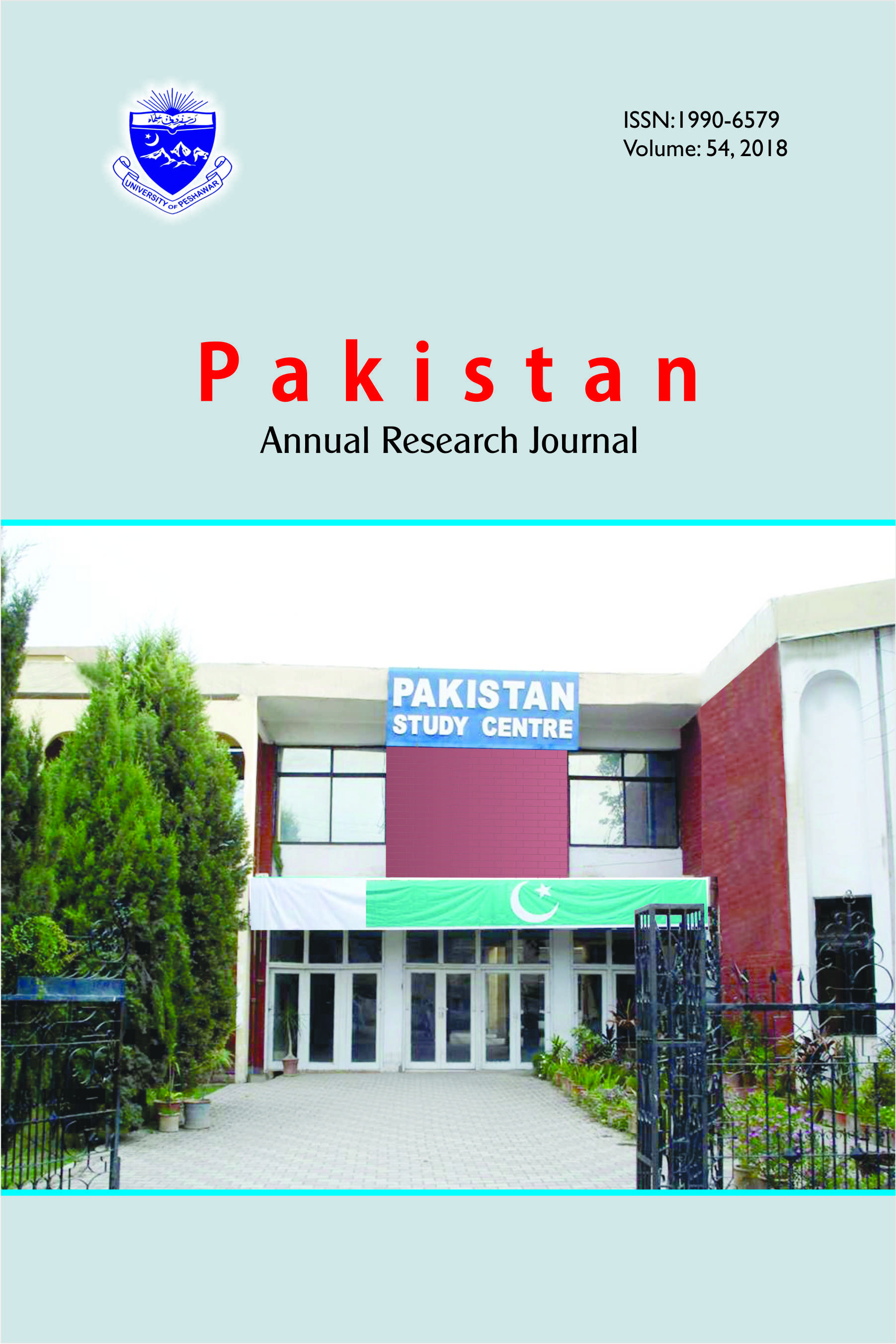AN ANALYSIS OF THE PRE AND POST RELEASE SERVICES TO THE PRISONERS AND ITS IMPACT ON THEIR REINTEGRATION (A CASE STUDY OF SELECTED PRISONS OF KHYBER PAKHTUNKHWA, PAKISTAN
Keywords:
Prisoners, Central Jails, Inmates, Release, ReintegrationAbstract
This paper has gauged the existence and effectiveness of pre and post release services to the prisoners in the context of Khyber-Pakhtukhwa (KP), Pakistan prisons. Seven jails of Khyber-Pakhtunkhwa, Pakistan including four central prisons i.e., Peshawar, Bannu, Haripure, DI khan and three district prisons i.e., Temargara, Mardan and Kohat were purposively selected. Out of 268 respondents, 250 jail inmates were randomly selected within the seven jails of the province and interviewed through semi-structured questionnaire. The remaining 18 respondents, purposively selected and interviewed through interview- guide included judges, lawyers, jail officials, human rights activists and ex-prisoners. Concurrent triangulation (Mixed methodology) was adopted to collect and analyze the data. It was found that prisoners in Pakistan face myriad challenges (social, financial, jobs, psychological etc) in their post-release life which are stumbling blocks to their readjustment. Moreover, there was no effective network of educational, vocational, pre and post release interventions, nor government had any follow-up strategy for the released prisoners, making them prone to their past deviant life style. Released prisoners must be passed through a well calculated arrangement of pre and post release services. Media, NGOs and criminal justice agencies must aware people to extend their all-out support to the released and not treat them persona no grata. Government should revisit the laws (if any) which bar past convicted prisoners to be fit for any public office/government job and the whole criminal justice system (police, prisons, judiciary, parole and probation) needs to be streamlined.
References
3
7
Casey, J., and B. Jarman. "The social reintegration of ex-prisoners in council of Europe member states." (Brussels: Quaker Council for European Affairs, 2012)
Kole, B. Convicts say they don't even get lunch money, Los Angeles Times, (14th February 1993).
Harper, Gemma, and Chloë Chitty , Home Office Research ,The impact of corrections on re-offending: a review of' what works', (Development and Statistics Directorate, 2004), No.291
Niriella, Jeeva. "Desire of Reintegration of ex-prisoners–A Universal Approach." (2008), 5, Retrieved from: http://archive.cmb.ac.lk/research/bitstream/70130/1091/1/Jeeva %20Niriella_ Desire%20of%20Reintegration.pdf, accessed on 23rd of May 2015. Martynowicz, Agnieszka, and Martin Quigley. " It's Like Stepping on a Landmine...": Reintegration of Prisoners in Ireland. (Ireland: Irish Penal Reform Trust, 2010). p. 9
Ogilvie, Emma. "Post-release: the current predicament and the potential
strategies." Criminology Research Council Canberra, (2001),1.
United Nations. Custodial & non custodial measures: The prison system
criminal justice assessment toolkit. (New York: United Nation, 2006), 1 8 Daily Express, (24th February 2015)
Workman, Kim, "Back to Churchill–An Old Vision for Prisoner Reintegration.", Policy Quarterly Vol. 5(2), (2009). Retrieved from: http://ips.ac.nz/publications/files/d3882d12a55.pdf accessed on 27th
December 2013
Rujjanavet, Somphop. "Improving the reintegration of offenders into the
community: the current situation of Thai corrections." In 135th International 11 Senior Seminar Participants’ Papers, (2008), 142-9.
Ajala, E. M., and A. E. Oguntuase. "Effectiveness of After-care-services in the Reintegration and Supply of Labour after Incarceration in the Prisons: Lagos and Oyo States Prison Command Experience." African Research
Review 5 (2011), 185-198.
Borzycki, Maria, and Eileen Baldry. "Promoting integration: the provision of prisoner post-release services." Trends & issues in crime and criminal justice
262 (2003),1
Gall, Meredith Damien, Walter R. Borg, and Joyce P. Gall. Educational
research: An introduction. (Longman Publishing, 1996).
Robson, Colin. "Real world research: A resource for social scientists and
practitioners-researchers." (Massachusetts: Blackwell Pushers, 1993), 146 Creswell, John W., Vicki L. Plano Clark, Michelle L. Gutmann, and William E. Hanson. Advanced mixed methods research designs”. In A. Tashakkori & C. Teddlie (Eds.), Handbook of mixed methods in social and behavioral
research, Thousand Oaks, Sage, (2003).
Borzycki, Maria, and Eileen Baldry, .op. cite., (2003), 1
Griffiths, Curt Taylor, Yvon Dandurand, and Danielle Murdoch. The social reintegration of offenders and crime prevention, (National Crime Prevention
Centre, 2007), 4.
Neiderbach, Shelley, and Susan Iwansowski, Invisible wounds: Crime
victims speak., (Routledge 2014).
Bazemore, Gordon, and Jeanne Stinchcomb. "A civic engagement model of reentry: Involving community through service and restorative justice.", Fed.
Probation 68 (2004)
Ugwuoke, C. U. "Recidivism in Nigerian Prisons: A case study of Enugu
Prison." PhD diss., M. Sc thesis, Department of Sociology/Anthropology, 21 University of Nigeria, Nsukka, (1994).
Ugwuoke, Christopher Uchechukwu. Criminology: Explaining crime in the 22 Nigerian context. (Great AP Express Publishers, 2010).
Osaze, L. E. "Behind the Wall.", (Civil Liberties Organization publishers, 23 1996).
International Center for Counter Terrorism, P.4, Retrieved from: http://www.icct.nl/download/file/Hedayah- th ICCT%20Psychology%20Good%20Practices.pdf, accessed on 24 January
2014
Davis, Lois, R. Bozick, J. Steele, J. Saunders, and J. Miles. "Education and vocational training in prisons reduces recidivism, improves job outlook.",
RAND Corporation, (2013).
Esperian, John H. "The effect of prison education programs on recidivism."
Journal of Correctional Education, (2010), 316-334
Hawley, Jo, Ilona Murphy, and Manuel Souto-Otero. "Prison education and training in Europe: Current State of play and challenges." A report submitted by GHK to Directorate General for Education and Culture, (London:
European Commission, 2013), 7.
Grant, M., The importance of educational programs in jail and prisons.
Indiana: School of Humanities and Behavioral Science, (2014).
Human Rights Commission of Pakistan, Report on the State of the Human Rights in 2014. Lahore: Human Rights Commission, (2014), P.86, Retrieved
from: http://hrcp-web.org/hrcpweb/hrcp-annual-report-2015,
Government of Kyber-Pukhtunkwa, Annual Report 2013-14, (Peshawar:
Home Department Inspectorate of Prison, 2014), 27-28





